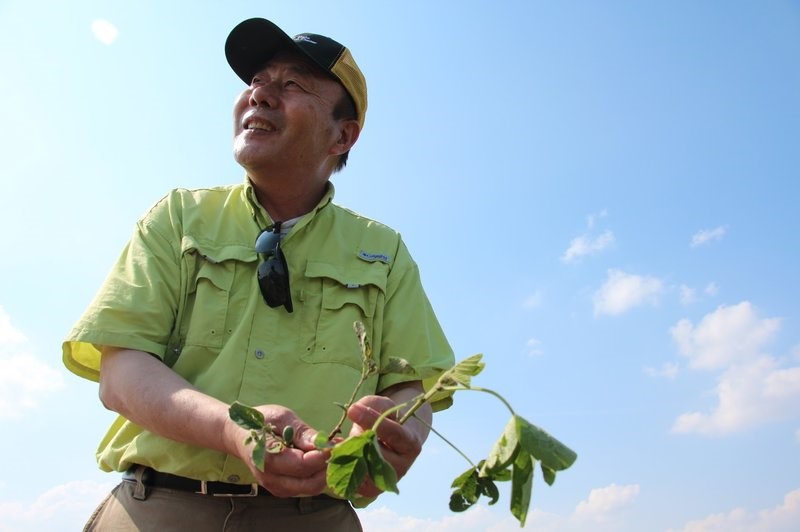25
Jul
Public Soybean Field Research Damaged by Pesticide Drift
 (Beyond Pesticides, July 25, 2019) Professors are experiencing damage to their soybean field research as a result of dicamba drift from neighboring agricultural fields. Experts worry that continued drift will make it impossible to carry out public research integral to non-genetically engineered soybean production. These reports, recent studies of dicamba drift potential, and numerous lawsuits counter Monsanto/Bayer’s claims that dicamba poses no drift threat when used properly.
(Beyond Pesticides, July 25, 2019) Professors are experiencing damage to their soybean field research as a result of dicamba drift from neighboring agricultural fields. Experts worry that continued drift will make it impossible to carry out public research integral to non-genetically engineered soybean production. These reports, recent studies of dicamba drift potential, and numerous lawsuits counter Monsanto/Bayer’s claims that dicamba poses no drift threat when used properly.
Monsanto, now owned by Bayer, manufactures both dicamba and genetically engineered, herbicide-tolerant crops. Dicamba mimics natural plant hormones, auxins, to cause uncontrolled and abnormal growth in non-tolerant plants; soybeans are especially vulnerable. Pengyn Chen, PhD, a professor of soybean breeding and genetics at the University of Missouri’s Fisher Delta Research Center, reports that his soybeans leaves curled up into cups and grew fragile unusual side branches due to dicamba drift.
Dr. Chen has seen damage for the past three years as dicamba use has increased around his research station. The nature of Dr. Chen’s work bars him from switching to dicamba resistant crops, a switch many farmers make to avoid the impacts of drift. Dr. Chen studies many varieties of soybeans, including obscure types that private companies ignore. His research aims to find combinations of soybean genes that maximize resilience and productivity. As a public soybean breeder, he produces seeds that are cheaper than private commercial varieties. However, Dr. Chen worries that the drift of pesticides like dicamba will make it impossible for such research and the public soybean market to survive. “If you kill the public research programs, who is going to study disease resistance, or stress tolerance? Those efforts are going to be gone,” says Dr. Chen.
Professors and soybean breeders at the University of Nebraska, Kansas State, and the University of Arkansas have also confirmed that their test plots exhibit exposure to dicamba. At the University of Arkansas, research station manager Mike Duren reports that his soybeans are showing similar symptoms to Dr. Chen’s, cupped leaves and pointed tips, hallmark signs of dicamba exposure. Duren notes that the only soybeans that are growing normally are the few plots of commercial dicamba-tolerant soybeans planted for comparison.
Bayer/Monsanto continues to say that dicamba does not cause problems when used properly. The company wrote in an email to NPR that they are aware of the damages to Dr. Chen’s research crop and that it is perhaps the result of a nearby farmer spraying an older, unauthorized version of the chemical. However, scientists and researchers continue to worry about the future of crop research. Projections indicate that 60% of all soybeans grown in the US will be dicamba tolerant this year, meaning that farmers will be spraying dicamba on about 50 million acres of land.
These new reports of damaged research crops support the need for better regulation of dicamba and other toxic pesticides that kill crops, impact wildlife, and pose a threat to human health when drift occurs. Environmental advocates say it is evident that current regulations are insufficient. Duren’s fields prove that even the 1 mile buffer zone required in Arkansas is inadequate protection.
Beyond Pesticides ultimately supports a transition away from toxic pesticides towards organic practices that promote pest resilience and decrease the need for these toxic chemicals. A wide variety of alternative practices and products are available to assist growers in this transition. In the meantime, we encourage you to reach out to local officials in your area to voice your concern regarding regulations and dicamba drift. If you think you may be experiencing the effects of drift, please visit our What to Do in a Pesticide Emergency page, and contact us for additional information.
All unattributed positions and opinions in this piece are those of Beyond Pesticides.
Source: NPR
Photo credit: Dan Charles/NPR










